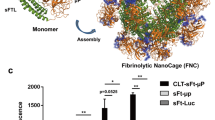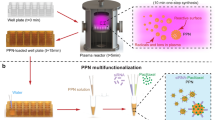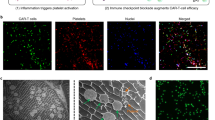Abstract
Drugs that induce thrombosis in the tumour vasculature have not resulted in long-term tumour eradication owing to tumour regrowth from tissue in the surviving rim of the tumour, where tumour cells can derive nutrients from adjacent non-tumoral blood vessels and tissues. Here, we report the performance of a combination of tumour-infarction therapy and chemotherapy, delivered via chitosan-based nanoparticles decorated with a tumour-homing peptide targeting fibrin–fibronectin complexes overexpressed on tumour-vessel walls and in tumour stroma, and encapsulating the coagulation-inducing protease thrombin and the chemotherapeutic doxorubicin. Systemic administration of the nanoparticles into mice and rabbits bearing subcutaneous or orthotopic tumours resulted in higher tumour growth suppression and decreased tumour recurrence than nanoparticles delivering only thrombin or doxorubicin, with histological and haematological analyses indicating an absence of detectable toxicity. The co-administration of a cytotoxic payload and a protease to elicit vascular infarction in tumours with biodegradable tumour-targeted nanoparticles represents a promising strategy for improving the therapeutic index of coagulation-based tumour therapy.
This is a preview of subscription content, access via your institution
Access options
Access Nature and 54 other Nature Portfolio journals
Get Nature+, our best-value online-access subscription
$29.99 / 30 days
cancel any time
Subscribe to this journal
Receive 12 digital issues and online access to articles
$99.00 per year
only $8.25 per issue
Buy this article
- Purchase on Springer Link
- Instant access to full article PDF
Prices may be subject to local taxes which are calculated during checkout





Similar content being viewed by others
Data availability
The main data supporting the results in this study are available within the paper and its Supplementary Information. The raw and analysed datasets generated during the study are too large to be publicly shared but are available for research purposes from the corresponding authors on reasonable request.
References
Bieker, R. et al. Infarction of tumour vessels by NGR-peptide-directed targeting of tissue factor: experimental results and first-in-man experience. Blood 113, 5019–5027 (2009).
Narazaki, M. & Tosato, G. Targeting coagulation to the tumour microvasculature: perspectives and therapeutic implications from preclinical studies. J. Natl Cancer Inst. 79, 705–707 (2005).
Huang, X. et al. Tumour infarction in mice by antibody-directed targeting of tissue factor to tumour vasculature. Science 275, 547–550 (1997).
Li, S. et al. A DNA nanorobot functions as a cancer therapeutic in response to a molecular trigger in vivo. Nat. Biotechnol. 36, 258–264 (2018).
Jahanban-Esfahlan, R., Seidi, K. & Zarghami, N. Tumour vascular infarction: prospects and challenges. Int. J. Hematol. 105, 244–256 (2017).
Dorfleutner, A. & Ruf, W. Regulation of tissue factor cytoplasmic domain phosphorylation by palmitoylation. Blood 102, 3998–4005 (2003).
Dienst, A. et al. Specific occlusion of murine and human tumour vasculature by VCAM-1-targeted recombinant fusion proteins. J. Natl Cancer Inst. 97, 733–747 (2005).
Wickstrom, M., Larsson, R., Nygren, P. & Gullbo, J. Aminopeptidase N (CD13) as a target for cancer chemotherapy. Cancer Sci. 102, 501–508 (2011).
Schwoppe, C. et al. Anticancer therapy by tumour vessel infarction with polyethylene glycol conjugated retargeted tissue factor. J. Med. Chem. 56, 2337–2347 (2013).
Kleinschnitz, C. et al. Targeting coagulation factor XII provides protection from pathological thrombosis in cerebral ischemia without interfering with hemostasis. J. Exp. Med. 203, 513–518 (2006).
Renne, T. et al. Defective thrombus formation in mice lacking coagulation factor XII. J. Exp. Med. 202, 271–281 (2005).
Coughlin, S. R. Thrombin signaling and protease-activated receptors. Nature 407, 258–264 (2000).
Carmeliet, P. Clotting factors build blood vessels. Science 293, 1602–1604 (2001).
Wu, X. Y., Ma, W., Gurung, K. & Guo, C. H. Mechanisms of tumour resistance to small-molecule vascular disrupting agents: treatment and rationale of combination therapy. J. Formos. Med. Assoc. 112, 115–124 (2013).
von Maltzahn, G. et al. Nanoparticles that communicate in vivo to amplify tumour targeting. Nat. Mater. 10, 545–552 (2011).
Stucke-Ring, J. et al. Combinatorial effects of doxorubicin and retargeted tissue factor by intratumoural entrapment of doxorubicin and proapoptotic increase of tumour vascular infarction. Oncotarget 7, 82458–82472 (2016).
Van der Veldt, A. A. M. et al. Rapid decrease in delivery of chemotherapy to tumours after anti-VEGF therapy: implications for scheduling of anti-angiogenic drugs. Cancer Cell 21, 82–91 (2012).
Sandler, A. et al. Paclitaxel-carboplatin alone or with bevacizumab for non-small-cell lung cancer. N. Engl. J. Med. 355, 2542–2550 (2006).
Batchelor, T. T. et al. AZD2171, a Pan-VEGF receptor tyrosine kinase inhibitor, normalizes tumour vasculature and alleviates edema in glioblastoma patients. Cancer Cell 11, 83–95 (2007).
Ding, Y. P., Li, S. P. & Nie, G. J. Nanotechnological strategies for therapeutic targeting of tumour vasculature. Nanomedicine 8, 1209–1222 (2013).
Chauhan, V. P. & Jain, R. K. Strategies for advancing cancer nanomedicine. Nat. Mater. 12, 958–962 (2013).
Liu, Z. et al. In vivo biodistribution and highly efficient tumour targeting of carbon nanotubes in mice. Nat. Nanotechnol. 2, 47–52 (2007).
Qian, X. et al. In vivo tumour targeting and spectroscopic detection with surface-enhanced Raman nanoparticle tags. Nat. Biotechnol. 26, 83–90 (2008).
Weissleder, R. et al. Cell-specific targeting of nanoparticles by multivalent attachment of small molecules. Nat. Biotechnol. 23, 1418–1423 (2005).
Benezra, M. et al. Multimodal silica nanoparticles are effective cancer-targeted probes in a model of human melanoma. J. Clin. Invest. 121, 2768–2780 (2011).
Bhattarai, N., Gunn, J. & Zhang, M. Chitosan-based hydrogels for controlled, localized drug delivery. Adv. Drug Deliv. Rev. 62, 83–99 (2010).
Amoozgar, Z., Park, J. Y., Lin, Q. N. & Yeo, Y. Low molecular-weight chitosan as a pH-sensitive stealth coating for tumour-specific drug delivery. Mol. Pharm. 9, 1262–1270 (2012).
Pilch, J. et al. Peptides selected for binding to clotted plasma accumulate in tumour stroma and wounds. Proc. Natl Acad. Sci. USA 103, 2800–2804 (2006).
Simberg, D. et al. Biomimetic amplification of nanoparticle homing to tumours. Proc. Natl Acad. Sci. USA 104, 932–936 (2007).
Agemy, L. et al. Nanoparticle-induced vascular blockade in human prostate cancer. Blood 116, 2847–2856 (2010).
Lip, G. Y. H., Chin, B. S. P. & Blann, A. D. Cancer and the prothrombotic state. Lancet Oncol. 3, 27–34 (2002).
Tomita, Y. et al. Long-term, repeated measurements of mouse cortical microflow at the same region of interest with high spatial resolution. Brain Res. 1372, 59–69 (2010).
Acknowledgements
This work was supported by grants from the National Key R&D Program of China (grant nos. 2018YFA0208900 and 2018YFE0205300), the Strategic Priority Research Program of Chinese Academy of Sciences (grant no. XDB36000000), National Natural Science Foundation of China (grant nos. 31730032, 31820103004, 31728007, 81871489 and 91859118), K.C. Wong Education Foundation (grant no. GJTD-2018-03) and the National Postdoctoral Program for Innovative Talents (grant no. BX20180083).
Author information
Authors and Affiliations
Contributions
S.L., Y.W., Y.Zhao and G.N. conceived and designed the experiments. S.L., Y.Zhang, B.L., M.W., X.D., N.Y., G.L., Z.L. and J.X. performed the experiments. S.L., Y.Zhang, Y.W., Y.Zhao and G.N. analysed the data and supervised the project. S.L., Y.W., Y.Zhao and G.N. wrote the manuscript and all authors discussed the results and commented on the manuscript.
Corresponding authors
Ethics declarations
Competing interests
The authors declare no competing interests.
Additional information
Publisher’s note Springer Nature remains neutral with regard to jurisdictional claims in published maps and institutional affiliations.
Supplementary information
Supplementary Information
Supplementary methods, figures and tables.
Rights and permissions
About this article
Cite this article
Li, S., Zhang, Y., Ho, SH. et al. Combination of tumour-infarction therapy and chemotherapy via the co-delivery of doxorubicin and thrombin encapsulated in tumour-targeted nanoparticles. Nat Biomed Eng 4, 732–742 (2020). https://doi.org/10.1038/s41551-020-0573-2
Received:
Accepted:
Published:
Issue Date:
DOI: https://doi.org/10.1038/s41551-020-0573-2
This article is cited by
-
Coordinated modulation of long non-coding RNA ASBEL and curcumin co-delivery through multicomponent nanocomplexes for synchronous triple-negative breast cancer theranostics
Journal of Nanobiotechnology (2023)
-
Near-infrared-II photoacoustic imaging and photo-triggered synergistic treatment of thrombosis via fibrin-specific homopolymer nanoparticles
Nature Communications (2023)
-
New era of nanoparticles facilitated co-delivery in cancer therapy: two heads are better than one
Journal of Nanoparticle Research (2023)
-
Injectable magnetic montmorillonite colloidal gel for the postoperative treatment of hepatocellular carcinoma
Journal of Nanobiotechnology (2022)
-
Recent advances in smart nanoplatforms for tumor non-interventional embolization therapy
Journal of Nanobiotechnology (2022)



